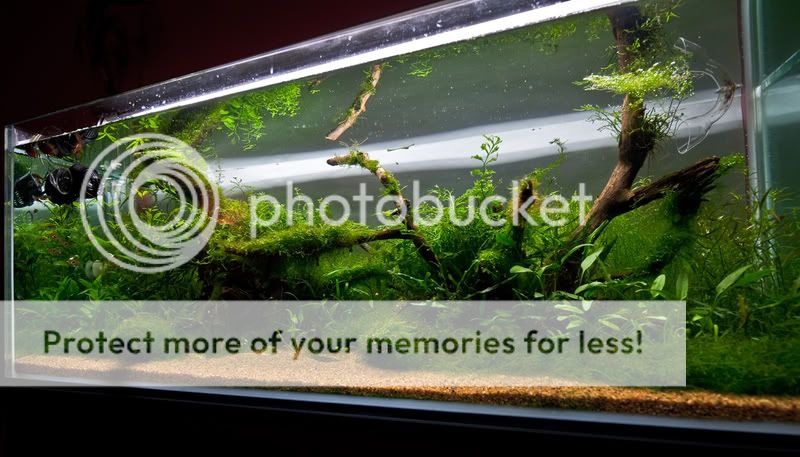owen.h.lewis
New Member
- Joined
- Mar 23, 2009
- Messages
- 34
- Reaction score
- 0
Hi all,
Below is a post i made the other week:
Hi all,
Recently i have noticed that my PH is quite low, and i was wondering if it is due to the inclusion of imported mangrove root wood to my tank. I have prepared the wood by boiling it for some time, along with taking it into the shower with me (dedication) and soaking it in water.
My tank is a 145 litre setup and has the following fish/plants etc -
3 x small plattys
4 x small guppies
2 x spotted corys
2 x angelfish
4 x neon tetra's
2 x glo light tetra's
I have got a bunch of amazon sword planted, along with some hairgrass, and also another bristly plant which i am unaware of the name.
I have an inbuilt filter that came with the tank, along with the lighting (gets 12 hours of light a day), and also a side mounted airpump which seems to act as a filter also (has a sponge like unit that is in the tank).
My tap water parameters is as follows:
Ph: 6.8
Ammonia: 0
Nitrite: 0
Nitrate: 0
GH Degree: 1 degree
My tank pre wood was as follows:
Ph: 6.5 - 6.6
Ammonia: 0
Nitrite: 0
Nitrate: less than 5
GH Degree: 4 Degree
Today (one and half weeks after adding wood) my results were:
Ph: 6.0
Ammonia: 0
Nitrite: 0
Nitrate: less than 5
GH Degree: 5 degree
I am worried about the low PH and wondered if this was due to the inclusion of the wood. Do i just need to do a water change and then it should hopefully hover around the 6.5 mark where it's ideally been at.
Any help would be great.
Cheers.
Ok so further to this i added a small amount of Ph up, and my ph was raised to 6.4 (tested within a few hours after addition) which is fine, although i would prefer it to be around 6.8 - 7.0.
Anyways, I completed a large water change, the first since introducing my wood, and then 2 days later tested my parameters and ph had risen to 7.4 + (Blue reading)
I would like to know what could be the possible causes? Does ph up take longer time to have an affect on the water? Also I have since added some ph down, just to try and get it around the neutral mark before i work out what's happening in my tank.
Originally i would just do a water change, as my ph was fine out of the tap, and that was that, but since adding the wood, my ph was dropping, i really dont want to keep adding ph up/down and would like to know what i can do, so that i can just do my water changes, and not have to worry as much about the ph varying.
Thanks in advance.
Below is a post i made the other week:
Hi all,
Recently i have noticed that my PH is quite low, and i was wondering if it is due to the inclusion of imported mangrove root wood to my tank. I have prepared the wood by boiling it for some time, along with taking it into the shower with me (dedication) and soaking it in water.
My tank is a 145 litre setup and has the following fish/plants etc -
3 x small plattys
4 x small guppies
2 x spotted corys
2 x angelfish
4 x neon tetra's
2 x glo light tetra's
I have got a bunch of amazon sword planted, along with some hairgrass, and also another bristly plant which i am unaware of the name.
I have an inbuilt filter that came with the tank, along with the lighting (gets 12 hours of light a day), and also a side mounted airpump which seems to act as a filter also (has a sponge like unit that is in the tank).
My tap water parameters is as follows:
Ph: 6.8
Ammonia: 0
Nitrite: 0
Nitrate: 0
GH Degree: 1 degree
My tank pre wood was as follows:
Ph: 6.5 - 6.6
Ammonia: 0
Nitrite: 0
Nitrate: less than 5
GH Degree: 4 Degree
Today (one and half weeks after adding wood) my results were:
Ph: 6.0
Ammonia: 0
Nitrite: 0
Nitrate: less than 5
GH Degree: 5 degree
I am worried about the low PH and wondered if this was due to the inclusion of the wood. Do i just need to do a water change and then it should hopefully hover around the 6.5 mark where it's ideally been at.
Any help would be great.
Cheers.
Ok so further to this i added a small amount of Ph up, and my ph was raised to 6.4 (tested within a few hours after addition) which is fine, although i would prefer it to be around 6.8 - 7.0.
Anyways, I completed a large water change, the first since introducing my wood, and then 2 days later tested my parameters and ph had risen to 7.4 + (Blue reading)
I would like to know what could be the possible causes? Does ph up take longer time to have an affect on the water? Also I have since added some ph down, just to try and get it around the neutral mark before i work out what's happening in my tank.
Originally i would just do a water change, as my ph was fine out of the tap, and that was that, but since adding the wood, my ph was dropping, i really dont want to keep adding ph up/down and would like to know what i can do, so that i can just do my water changes, and not have to worry as much about the ph varying.
Thanks in advance.



